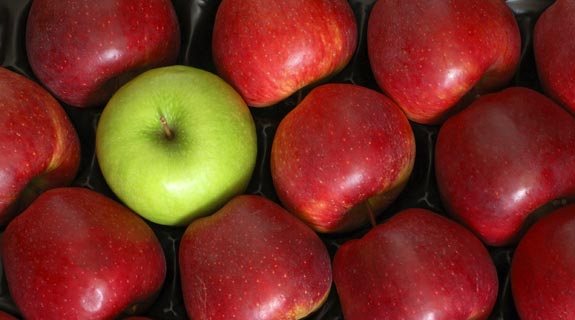What do Adam and Eve, Isaac Newton, William Tell and Snow White have in common?
What do Adam and Eve, Isaac Newton, William Tell and Snow White have in common? The humble apple. Alessandra Zecchini explores this versatile fruit
The apple is one of the most popular fruits on earth, with about 7,500 varieties eaten across the globe.
New Zealand has a rich apple-growing history, and I am fortunate to live among the few remaining apple orchards of Oratia, in Waitakere City. Many orchards on city fringes are no longer economic, and it’s sad to see them disappearing. Many heirloom apples have also been lost, replaced by more commercially successful apple varieties.
Eating apples in season is a real treat (from late summer to late autumn)—and buying them local and fresh can’t be beaten. Supermarket apples, available all year round, are just not the same. They are picked unripe and kept in climate-controlled conditions for months on end.
I make the most of apples during autumn, popping down to the local Dragicevich Orchard, where some of the trees are about 100 years old. I hope that heirloom varieties such as the Oratia Beauty will never disappear.
As well as freshly picked apples, Carmela Dragicevich and her son Mate sell the best juice ever. Fresh apple juice is a good source of vitamin C, unlike commercially produced juices which lose goodness in the processing and are often fortified with vitamins.
Apples provide easily digestible fibre. It is believed that they help reduce the risk of colon cancer, heart disease and cholesterol build-up in arteries.
As a bonus, they also contain pectin, a gelling and thickening agent and a food stabiliser. Add an apple or some peelings to curry and other sauces for a creamier consistency, or to jam to help it set.

Photo by Alessandra Zecchini
Apple and carrot salad
with hazelnuts
Serves 4
Apples complement both sweet and savoury dishes. Arguably, they are at their best when eaten raw, like in this fresh, flavoursome and crunchy salad
- Juice of 1 lemon
- 2 organic green apples
- 1 organic red apple
- 2 large organic carrots
- 1 tbsp shelled and toasted hazelnuts, crushed
- 1 tbsp extra-virgin olive oil
- Salt and pepper to taste
- Fresh tarragon leaves to decorate
Wash the apples and, without peeling them, cut into very thin slices, removing the pips. Before they go brown, quickly mix the apple slices with half the lemon juice in a large salad bowl.
Wash and scrape the carrots, then grate and mix with the remaining lemon juice. Add extra-virgin olive oil, salt and pepper to taste.
Before serving, mix the carrots and the apples, then sprinkle with the crushed hazelnuts and decorate with a few leaves of tarragon.
Pinza
Serves 20
Pinza is a popular apple cake from the north-eastern region of Veneto in Italy. Traditionally made with a combination of white flour and cornmeal, apples and dried fruit, this simple but filling cake can feed a small army.
- 100g sultanas
- 50g candied citrus peel
- 50g candied cherries, chopped
- 100g walnut kernels
- 50ml brandy or grappa (a traditional Italian distillate)
- 1 litre water
- 500ml milk
- 100g white flour
- 200g cornmeal
- 1 pinch of salt
- 150g sugar
- 4 apples, peeled and sliced
- 150g butter, plus more to grease the cake pan
Soak the sultanas, candied fruit and walnuts in the brandy or grappa and set aside.
In a very large saucepan bring the water and milk to a gentle boil. Turn the heat to low and sieve in the flour, salt and cornmeal.
Stir for 20 minutes, then add the sugar, apple slices, marinated dried fruit plus any remaining liquid and butter.
Stir until the butter has melted then pour into a 22cm round cake pan with high borders, well greased with butter or lined with baking paper. Bake at 180ËšC for 40 minutes. Allow cake to cool before serving.

Photo by Alessandra Zecchini
Apple sauce
You don’t get much more homely than apple sauce. Though traditionally an accompaniment to pork roast, apple sauce is also good as a spread on toast, on porridge, or as a pie filling. Make to use the same day, or preserve for winter
- 8 apples (I like to use red apples)
- A little lemon juice
- 1 cup of water
- 1 cinnamon stick
- Sugar (only for preserves)
Wash the apples and, without peeling them, cut into quarters, removing the pips. Place the apples in a large saucepan with the lemon juice, cinnamon stick and water. Bring to the boil and simmer until the apples are very soft (about 30 minutes).
Remove the cinnamon stick and, with the help of a wooden spoon, strain the apples and their water through a sieve to remove the skins. This takes time but will produce a lovely smooth sauce.
If serving fresh, there is no need to add any sugar. The sauce can be stored in the fridge for up to one week.
For bottled sauce, allow half a cup of sugar for each cup of apple sauce.
Put the sauce back into the saucepan and bring to a gentle simmer. Add the sugar and stir well for a few minutes, until the sugar has dissolved. Sterilise clean jars by placing them on racks in the oven for about 15 minutes at 130°C.
Place the hot apple sauce in the still warm jars and seal them—either using cellophane covers (available in supermarkets) that are secured with elastic bands, or capsule lids (I use the Quattro Stagioni brand).
If using capsule lids, place the jars in a pot and cover with water. Bring to the boil and simmer for 20–30 minutes, depending on the size of the jars. Let the jars cool in the pot overnight. Then make sure that the capsule has popped down by pressing gently on the lid.
Apple sauce in cellophane-covered jars will last for several months and in capsule-lid jars for up to one year. Store in a cool, dark cupboard.





